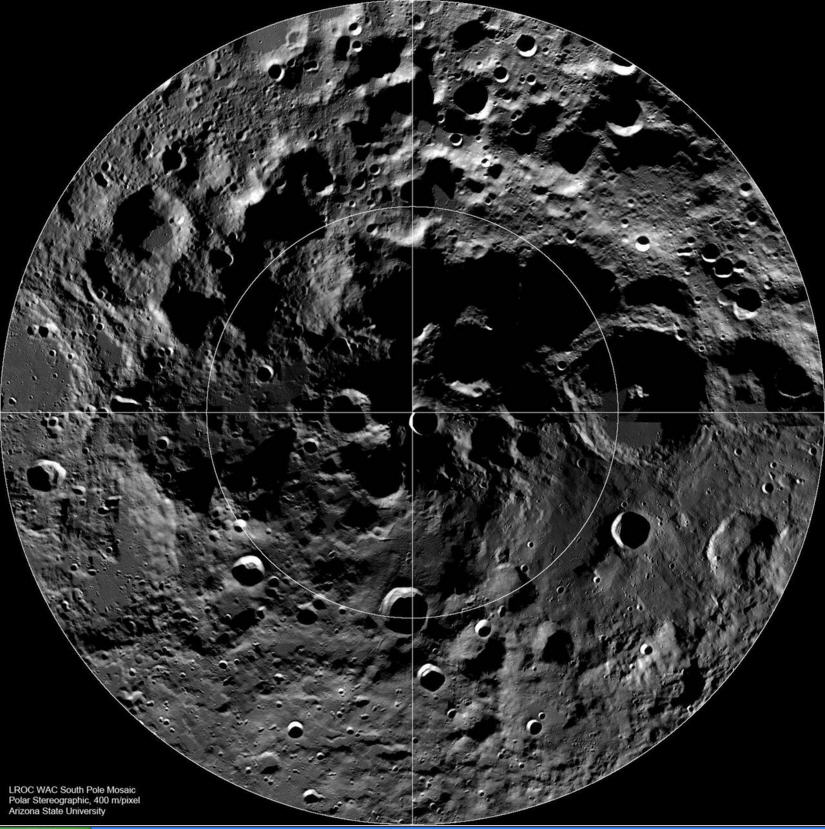 精选
精选
月球上的二氧化碳冷阱首次被证实
诸平

A view of the lunar south pole, where newly confirmed carbon dioxide cold traps are located, according to new research in Geophysical Research Letters. Future missions on the Moon may target this region to find out more about the resources that may exist there. Credit: NASA/GSFC/Arizona State University
据美国地球物理联合会(American Geophysical Union)2021年11月15日提供的消息,月球上的二氧化碳冷阱首次被证实(Carbon dioxide cold traps on the moon are confirmed for the first time)。上述照片是一幅月球南极的照片,新证实的二氧化碳冷阱位于那里。未来的月球任务可能会以这一地区为目标,以了解那里可能存在的更多资源。相关研究结果于2021年10月7日已经在《地球物理研究快报》(Geophysical Research Letters)杂志网站发表——Norbert Schorghofer, Jean-Pierre Williams, Jose Martinez-Camacho, David A. Paige, Matthew A. Siegler. Carbon Dioxide Cold Traps on the Moon. Geophysical Research Letters, First published: 07 October 2021. DOI: 10.1029/2021GL095533. https://doi.org/10.1029/2021GL095533.
经过几十年的不确定之后,研究人员证实了月球二氧化碳冷阱的存在,这些冷阱可能含有固体二氧化碳。这一发现可能会对未来月球任务的形成产生重大影响,并可能影响机器人或人类在月球上持续存在的可行性。
在月球两极的永久阴影区域,温度低于冥王星最冷地区的温度,这使得二氧化碳成为冷阱。在这些寒冷的陷阱中,二氧化碳分子可以冻结并保持固体形态,即使在月球夏季的最高温度。
未来的人类或机器人探险者可以利用这些冷阱中的固体二氧化碳生产燃料或材料,以便在月球上停留更长时间。二氧化碳和其他潜在的挥发性有机物也可以帮助科学家更好地了解月球上的水和其他元素的起源。
尽管多年来行星科学家们一直在预测冷阱的存在,但这项新研究是第一次坚定地建立和绘制二氧化碳冷阱存在的地图。为了找到月球表面最冷的地方,研究人员分析了来自预言者月球辐射计实验(Diviner Lunar Radiometer Experiment简称DLRE)中11年的温度数据,DLRE是美国国家航空航天局(NASA)月球勘测轨道飞行器(NASA's Lunar Reconnaissance Orbiter)上的一个仪器。
这项新研究发表在AGU的《地球物理研究快报》(Geophysical Research Letters)杂志上,该杂志发表了高冲击力的短格式报告,对所有地球和空间科学都有直接影响。研究表明,这些冷阱包括几个集中在月球南极周围的区域。这些二氧化碳陷阱的总面积为204 km2,最大的区域是阿蒙森火山口(Amundsen Crater),拥有82 km2的陷阱。在这些地区,温度持续保持在60 K(约零下352℃)以下。
研究人员称,二氧化碳冷阱的存在并不能保证月球上存在固体二氧化碳,但这一证实确实使未来的任务很有可能在月球上发现二氧化碳冰。
该研究的第一作者、行星科学研究所(Planetary Science Institute)的行星科学家Norbert Schörghofer说:“我想,当我开始研究时,我的问题是,‘我们能否自信地说月球上存在二氧化碳冷阱?’我惊讶的是,它们确实在那里。可能是因为我们无法确定它们的存在,(它们可能)只是地图上的一个像素……所以我认为令人惊讶的是,我们真的发现了毫无疑问是足够冷的连续的区域。”
管理月球(Managing the moon)
月球上二氧化碳陷阱的存在可能会对未来月球探索的规划和有关资源的国际政策产生影响。
如果这些冷阱中确实存在固态二氧化碳,那么它可能会以多种方式被利用。未来的太空探索者可以利用这些资源来生产钢铁、火箭燃料和生物材料,这些都是机器人或人类在月球上持续存在的必要条件。这种潜力已经吸引了政府和私营企业的兴趣。
科学家还可以研究月球上的碳,以了解有机化合物(organic compounds)是如何形成的,以及在这些恶劣的环境中会自然产生什么样的分子。
科罗拉多大学博尔德分校(University of Colorado, Boulder)的行星科学家保罗·海恩(Paul Hayne)表示,二氧化碳冷阱(carbon dioxide cold traps)还可以帮助科学家解答长期存在的关于地月系统(Earth-moon system)中水和其他挥发物起源的问题。保罗·海恩并未参与此项研究。
二氧化碳可以作为月球表面水和其他挥发物来源的示踪剂,帮助科学家了解它们是如何抵达月球和地球的。
保罗·海恩说:“这些应该是未来着陆任务的优先目标。这类精确定位了你在月球表面可能会去的地方,以回答一些关于月球挥发物和它们从太阳系其他地方输送的重大问题。”
上述介绍,仅供参考。欲了解更多信息,敬请注意浏览原文或者相关报道。
Water ice is expected to be trapped in permanently cold regions near the lunar poles. Other ices (“super-volatiles”) are trapped at lower temperatures, close to the lowest temperatures measured within the lunar permanently shadowed regions (PSRs). Here, the thermal stability of solid carbon dioxide in the south polar region is determined by analysis of 11 years of temperature measurements by Diviner, a radiometer onboard the Lunar Reconnaissance Orbiter. Sublimation rates averaged over a draconic year are far lower than peak sublimation rates. Small spatially contiguous pockets of CO2 ice stability are found in the craters Amundsen, Haworth, de Gerlache, and others, over a cumulative area of roughly 200 km2. The LCROSS probe impacted one of those pockets and released CO2, serving as validation of the thermal stability calculations. Future surface missions can utilize this highly localized resource for the production of fuel, steel, and biological materials.
Carbon-bearing species would be essential for sustained robotic or human presence on the Moon, for use in rocket fuel and biological materials. Various volatiles can be cold-trapped in permanently shadowed craters near the lunar poles. The existence of carbon dioxide cold traps has previously been surmised, but the required temperatures are near the lowest surface temperatures that have been reliably measured. Extensive and improved analysis of 11 years of orbital surface temperature measurements establishes the existence of carbon dioxide cold traps on the Moon, which potentially host high concentrations of solid carbon dioxide. Large CO2 cold traps are rare, however, and the geographic concentration of the resource will have policy implications.
转载本文请联系原作者获取授权,同时请注明本文来自诸平科学网博客。
链接地址:https://wap.sciencenet.cn/blog-212210-1312701.html?mobile=1
收藏


